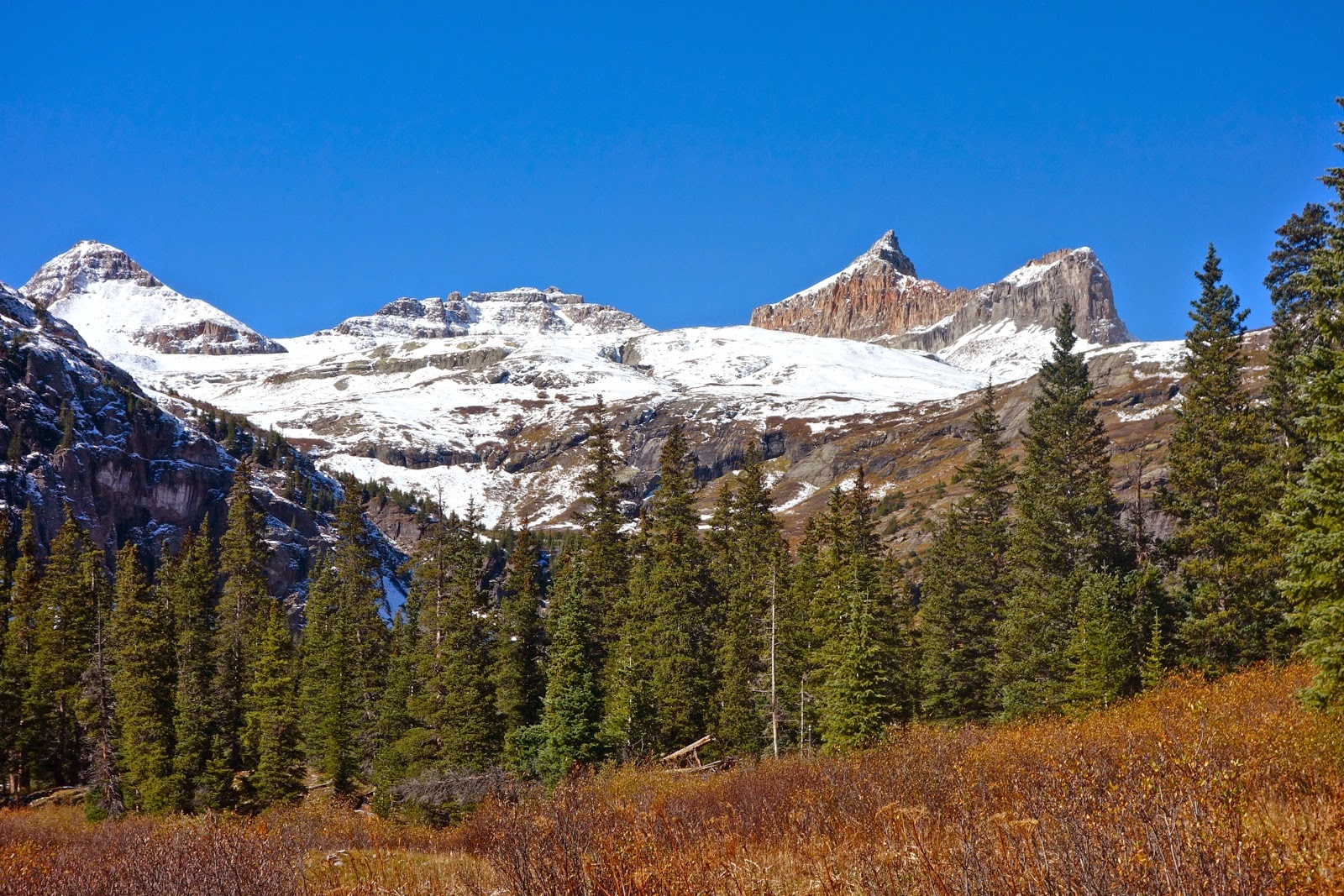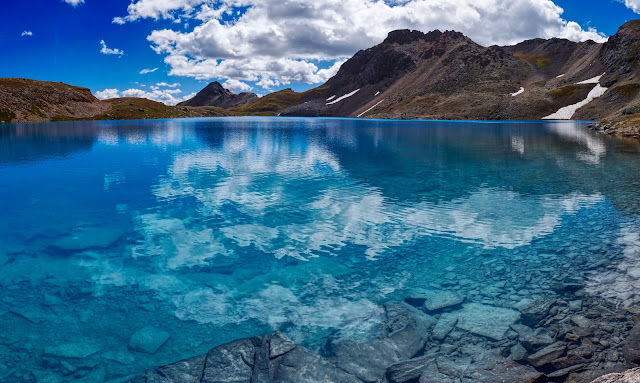As seen from Lizard Head Pass, Yellow Mountain owns the entire ridge left/northwest of Pilot Knob, shown on the right. Yellow Mountain North is the tallest summit at the left end of the ridge while Yellow Mountain South is the first highpoint left of Pilot Knob.
Travel: Ophir Pass Route: In a 4WD/HC vehicle, from Durango, drive north on US 550 about 47 miles to Silverton. Zero out your trip meter and continue north on 550 towards Ouray. The sign for Ophir Pass is at 4.8 miles. Make a left and go steeply downhill on San Juan CR 8. Cross Mineral Creek noting the sign, "Recommended HC 4WD." At spurs, stay on the main road as it narrows to a more obvious shelf. Most of the distance is a shelf road so take the highway route if you are squeamish. In places the track is no wider than the wheels. At 7.9 miles, make a switchback to the right, avoiding the left spur. Ophir Pass, at 9.1 miles, 11,789 feet, is situated between North and South Lookout Peaks. So much for the easy side. On the west, the road gets much steeper with big, sharp rocks, dangerous for ordinary tires. The sharp switchback at the end of the first traverse has a big hole. If there are upcoming vehicles, wait until the road clears at the switchback because the next mile is a no-pass zone. The narrow, rough, exposed shelf is etched into a talus slope. Thread between the pillars and soon enter the trees where travel improves. Reach the town of Ophir at 12.1 miles. Follow the main road as it turns. At 12.4 miles, make a hard left and park immediately. A plaque honoring the Utes, located in a small stand of trees, marks the trailhead. Allow 1:40 to 2:00 from Durango.
Ophir Pass Road is not for everybody and certainly not for every vehicle. It is fairly typical of 4WD passes in the San Juans...rough, exposed, and resplendent. For those who do it, the drive is a bonus feature.
Highway Route: Ophir is located east of Hwy 145. The turn-off is between Telluride and Lizard Head Pass. In Ophir, drive east on Granite Street to the trailhead described above.
Distance and Elevation Gain: It is 8.7 miles roundtrip with 3,550 feet of vertical to climb the peak. If you continue out the northwest ridge it is 10 miles with 4,000 feet of climbing.
Time: Peak only, 5:30 to 6:30; full tour, 6:30 to 8:00
Difficulty: Mining track, trail, off-trail; navigation moderate; mild exposure on optional trek northwest of peak
Map: Ophir, Colorado 7.5 Quad
Latest Date Hiked: August 31, 2017
Quote: The sound of colors is so definite that it would be hard to find anyone who would express bright yellow with base notes, or dark lake with the treble. Wassily Kandinsky, painter
Route: The hike begins on an abandoned road in the town of Ophir, a favorite for dog-walking locals. The road stays east of Waterfall Creek, pinching to a good trail all the way up into the first of three basins. This is where most people turn around; the route from there is essentially off-trail. Ascend twice more into ever loftier basins, all the while in the company of Waterfall Creek, before claiming the saddle southeast of Yellow Mountain South. From there, it is a simple hike to the peak followed by an optional out-and-back to elevation 12,700 feet.
Trailhead 9,756' is marked by a small stand of trees and a plaque honoring the Ute People, "Whose feet once walked this valley..." Yellow Mountain takes up the entire high earthline.
Walk southeast downhill on a blocked-off track, passing below cabins and homes. Cross Howard Fork on a footbridge and regain the road. (In 2017, the bridge was washed out but the substitute makeshift crossing is fine.) Enjoy a pleasant uphill trek through an aspen/fir forest. While the course ambles, Yellow Mountain South is due south from the trailhead. At 0.5 mile, the road splits; take the left spur on the more established track. On our first trip we mistakenly went right to stay close to Waterfall Creek and got drenched by tangled masses of flora.
The terrain opens into a gorgeous valley, "Waterfall Gulch." The creek holds down the center.
At 1.0 mile, stay left and at 1.2 miles, come to mine ruins. The road ends. A trail goes through the ruins and into a clearing. At 1.7 miles, cross a small ravine and then see the big wall that marks the south end of Waterfall Gulch. The first waterfall of the day plummets down through the trees. Meanwhile, Yellow Mountain is to the southwest, a verdant forest crawling up the sides of its water-stained walls, shown.
To breech the wall, the trail makes an ascending southeast traverse. The steepness of the no-nonsense track is tempered by good views of the waterfall. In autumn, geranium and fireweed leaves set the morning aflame.
(THW, photo)
At 2.3 miles, reach the cliffs at 11,200 feet. This is the contact between the Cutler Formation (below) and Telluride Conglomerate which makes up most of the cliffs. The trail makes an idyllic traverse along the base of the conglomerate mass and punches through a small opening in the rock. Top out at the north edge of what I'm calling Basin One.
Leave the trail and walk to the edge of the spectacular cascade at 2.5 miles, 11,300 feet. From the moment you enter the basin, the next challenge is visible. The second waterfall tumbles down a slit in the cliffs at the south end of the basin.
Return to the trail that emerged from the trees on the east side of Waterfall Creek. The further south you travel the sketchier the trail becomes. (In 2017, the track was more dependable.) Route finding is easy. Walk along the base of V3, 13,528 feet. Volcanic boulders have rolled from above onto her skirts and the valley floor. (THW, photo)
Stay left/east of Waterfall Creek. The white coating in the streambed is a precipitate of a hydrous aluminum sulfate called basaluminite. For an in-depth explanation of this phenomenon, see Rolling Mountain.
Go under the first set of cliffs left of the waterfall. It is a quick 200 foot climb into the next basin on a social trail.
Reach Basin Two at 3.2 miles, 11,840 feet. Walk past a peninsula, leaving trees behind for the remainder of the hike. (THW, photo)
A cataract plunges through the gorge.Two hikers stand on the precipitous edge of the peninsula.
Here's a shot from the peninsula looking up-basin. (THW, photo)
Start up the basin left of the creek. Watch for a wildcat trail at 12,000 feet going up a green slope on the right. Eventually it sputters out; just follow the rocky creek which has its own charms. The massive fin at the center of this image is actually the northface of Pilot Knob.
At 12,480 feet, 3.8 miles, enter Basin Three, the smallest of the set. For the first time, see Saddle 12,960' located at the base of Pilot Knob. Ascend the very steep green slope to the saddle at 4.2 miles.
Turn northwest and go over a yellow false summit to a second saddle. To scale the peak, shown, use a ramp on the right side of the ridge or climb straight up, my preferred route. Reach the peak at 4.4 miles.
Yellow South is an unranked summit (because there is less than 300 feet of vertical from its shared saddle with Pilot Knob). There is no register and very little evidence of traffic. However, the view is spectacular and so is the experience. Southwest are The Wilson's, Black Face, and Lizard Head. South is Grizzly Peak and San Miguel Peak. The V3, U S Grant Peak, V4 triplet, shown, is simply too wild for words. I have climbed U S Grant from Island Lake. We ran into a couple of Ophir residents on this hike who climbed it from this side. (THW, photo)
We hoped to reach Yellow North from Yellow South and while that proved impossible, the optional 0.7 walk to where the ridge cuts away is recommended. There is mild exposure on the narrow ridge for the first 0.2 mile. Then it opens onto a welcoming, broad plateau with uniformly small rock.
Continue past Point 12,838' to the rift in the ridge at 5.1 miles, 12,700 feet. There appear to be several game-over breaches in the ridge. For me anyway, Yellow North must be scaled another way.
From here, the town of Ophir is visible well below to the north. The ridge above town spans Ophir Needles, Silver Mountain, and Oscar's Peak.
On our return, we took a long, hard look at Pilot Knob. The locals who climbed U S Grant from the Waterfall Creek side were back to attempt Pilot without ropes. Most people consider it a technical climb. Return to the trailhead as you came. However, upon leaving Yellow South, there is no need to re-climb the false summit. Simply descend from the first saddle as indicated on the track above.
In autumn the flowers were spent and had gone to seed. Considering how lush the lower reaches were, this would be a great mid-summer flower hike. Rayless senecio do not have ray flowers; here's a whimsical picture of them giving it all they're worth in mid-September.





























































